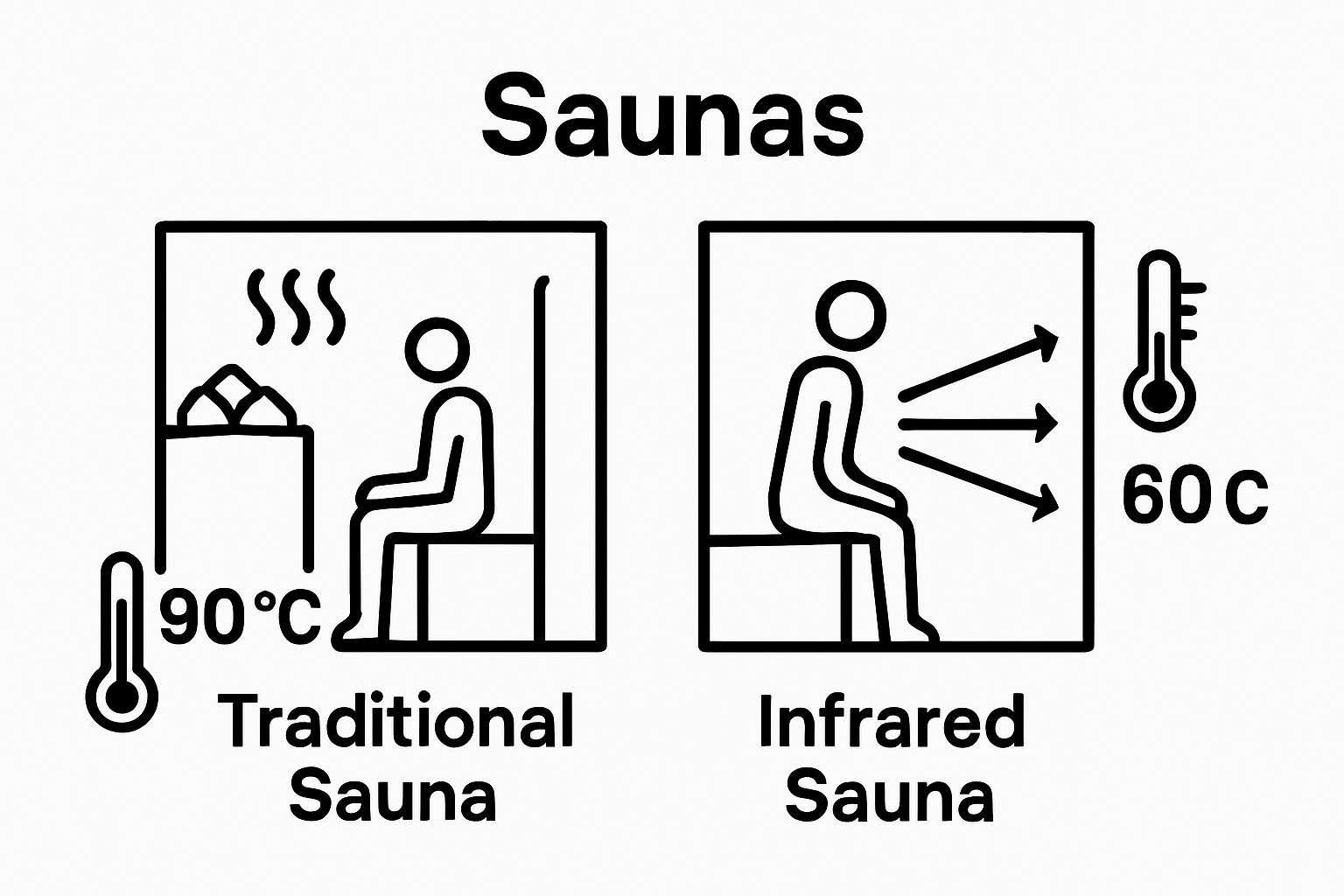
Understanding Infrared Sauna Benefits for Wellness
Infrared saunas are popping up in luxury spas and home wellness rooms across the country with more people drawn in by their sleek look and modern promise. Most assume they just offer a new way to sweat, maybe even a fancier version of the old wooden boxes at the gym. But the numbers flip expectations. Research shows infrared saunas can trigger cardiovascular responses that mimic moderate exercise and even help manage chronic pain conditions. The real story is not about challenging your heat tolerance but about harnessing invisible light waves that go deeper and deliver surprising health benefits.
Table of Contents
- What Are Infrared Saunas And How Do They Work?
- The Science Behind Infrared Heat And Its Benefits
- Health Benefits Of Infrared Saunas Explained
- Infrared Sauna Vs. Traditional Sauna: Key Differences
- Practical Applications Of Infrared Saunas In Daily Life
Quick Summary
| Takeaway | Explanation |
|---|---|
| Infrared saunas use electromagnetic waves | They directly warm the body, offering benefits without high temperatures. |
| Enhances cardiovascular health effectively | Mimics moderate exercise effects, improving heart rate and circulation. |
| Supports detoxification and stress reduction | Facilitates sweating and promotes relaxation, aiding mental well-being. |
| Helps manage chronic pain and inflammation | Clinical studies show significant symptom relief for certain conditions. |
| Gentler experience compared to traditional saunas | Lower temperatures and direct heat make them more comfortable for users. |
What are Infrared Saunas and How Do They Work?
Infrared saunas represent a modern wellness technology that transforms traditional heat therapy through advanced light wave principles. Unlike conventional saunas that heat surrounding air, infrared saunas utilize specialized electromagnetic waves to directly warm the human body, creating a unique therapeutic experience.
The Science Behind Infrared Technology
Infrared light exists within the electromagnetic spectrum as invisible waves that penetrate human tissue more effectively than standard heat sources. Mayo Clinic explains that these saunas use light to generate heat, allowing for deeper tissue warming at significantly lower ambient temperatures.
The core mechanism involves three primary infrared wavelengths:
- Near infrared waves: Shallow skin penetration
- Mid infrared waves: Deeper muscle and tissue engagement
- Far infrared waves: Maximum tissue penetration and potential metabolic benefits
Physiological Responses and Heat Interaction
When infrared waves contact human skin, they trigger a fascinating thermal response. Your body absorbs these light waves, which stimulate molecular vibration and generate internal heat. This process increases core body temperature more efficiently than traditional sauna methods, promoting profound physiological changes.
According to research published in Evidence-Based Complementary and Alternative Medicine, infrared saunas induce similar cardiovascular responses to moderate exercise. The body experiences increased heart rate, enhanced circulation, and substantial perspiration without the physical exertion associated with traditional workout routines.
Key physiological responses include:
- Accelerated metabolic processes
- Enhanced blood circulation
- Natural detoxification through sweating
- Potential reduction in muscle tension
By leveraging light wave technology, infrared saunas offer a scientifically advanced approach to wellness that goes beyond conventional heat therapy, providing a nuanced method for supporting overall human health and recovery.
The Science Behind Infrared Heat and Its Benefits
Infrared heat technology represents a sophisticated approach to wellness that transcends traditional thermal therapies. By harnessing electromagnetic waves with precise wavelength characteristics, this innovative technology offers a nuanced method of generating therapeutic warmth that interacts uniquely with human physiology.
Cellular Level Interactions and Thermal Response
At the microscopic level, infrared waves generate heat through direct molecular interaction. When these electromagnetic waves penetrate human tissue, they cause molecular vibration, creating internal thermal energy without conventional external heating mechanisms. Research from the National Institutes of Health indicates that this targeted heat generation can produce significant physiological responses, particularly in cardiovascular function and metabolic processes.
Key cellular interaction mechanisms include:
- Stimulation of mitochondrial activity
- Enhanced cellular metabolism
- Increased circulation through targeted thermal energy
- Potential activation of heat shock proteins
Physiological Benefits and Therapeutic Potential
The therapeutic landscape of infrared heat extends beyond simple warmth generation. Clinical studies demonstrate remarkable potential in addressing various health conditions. A comprehensive pilot study revealed that consistent infrared exposure could provide substantial benefits for individuals with chronic inflammatory conditions.
According to research examining rheumatoid and spondylitis patients, controlled infrared heat exposure demonstrated significant improvements in:
- Reduction of chronic pain symptoms
- Decreased joint stiffness
- Enhanced overall mobility
- Improved quality of life metrics
Additionally, metabolic research suggests that infrared heat therapy might play a critical role in supporting glucose metabolism and cardiovascular health. The body’s response to these controlled thermal waves mimics moderate exercise responses, generating substantial physiological adaptations without equivalent physical exertion.
By integrating advanced electromagnetic principles with human physiological understanding, infrared heat technology offers a sophisticated wellness approach that bridges scientific innovation and holistic health strategies.
Health Benefits of Infrared Saunas Explained
Infrared saunas have emerged as a powerful wellness technology, offering a multifaceted approach to health improvement that extends far beyond traditional heat therapy. By delivering targeted electromagnetic waves directly into human tissue, these innovative systems unlock a range of potential physiological and psychological benefits.
Cardiovascular and Metabolic Advantages
Cardiovascular health receives significant positive attention through infrared sauna usage. Research from the National Institutes of Health reveals compelling evidence of substantial cardiac function improvements. The controlled heat exposure mimics moderate cardiovascular exercise, generating remarkable physiological responses without equivalent physical strain.
Key cardiovascular benefits include:
- Enhanced blood circulation
- Reduced blood pressure
- Improved heart rate variability
- Potential reduction in arterial stiffness
Immune System and Chronic Condition Management
Beyond cardiovascular impacts, infrared saunas demonstrate promising potential in managing chronic inflammatory conditions. Emerging clinical studies suggest significant therapeutic applications for individuals experiencing persistent health challenges. Research examining patients with rheumatoid conditions indicates meaningful improvements in pain management and overall mobility.
Notable health management benefits encompass:
- Reduced chronic pain symptoms
- Decreased joint inflammation
- Enhanced immune system response
- Potential mitigation of autoimmune disorder symptoms
The profound thermal interaction stimulates complex physiological mechanisms, potentially supporting the body’s natural healing and regulatory processes. By generating controlled internal heat, infrared saunas trigger numerous cellular responses that contribute to overall wellness, including potential detoxification, stress reduction, and metabolic optimization.
Ultimately, infrared sauna technology represents a sophisticated convergence of scientific understanding and holistic health principles, offering individuals a non-invasive pathway to enhanced physiological performance and well-being.
Infrared Sauna vs. Traditional Sauna: Key Differences
The world of heat therapy presents two distinct technologies: traditional saunas and infrared saunas. While both aim to provide therapeutic warmth and wellness benefits, their fundamental mechanisms of heat generation and user experience differ significantly, offering unique advantages for different health and relaxation preferences.
Heating Mechanism and Temperature Dynamics
Traditional saunas rely on conventional heating methods, warming the surrounding air to extremely high temperatures between 70 and 100 degrees Celsius. In contrast, infrared saunas utilize advanced electromagnetic waves that directly penetrate human tissue, generating heat from within at substantially lower ambient temperatures.
Research from Evidence-Based Complementary and Alternative Medicine highlights critical distinctions in their operational principles:
- Traditional saunas heat air first, then body
- Infrared saunas warm body tissues directly
- Traditional saunas operate at higher temperatures
- Infrared saunas maintain cooler environmental conditions
User Experience and Physiological Response
The divergent heating approaches translate into markedly different user experiences.
Infrared saunas offer a more gentle, penetrative warmth that many find more comfortable and tolerable compared to the intense heat of traditional saunas. This technological variation means individuals with heat sensitivity or respiratory challenges might find infrared options more accessible.
Key experiential differences include:
- Lower perceived temperature in infrared saunas
- More direct heat absorption in infrared technology
- Reduced humidity compared to traditional saunas
- Potentially longer sustainable session duration
While both sauna types stimulate sweating and cardiovascular responses, infrared saunas provide a nuanced approach to thermal therapy.
To help readers understand the core distinctions, the following table compares key features of infrared saunas and traditional saunas as discussed in the article.
| Feature | Infrared Sauna | Traditional Sauna |
|---|---|---|
| Heating Mechanism | Electromagnetic infrared waves | Heats surrounding air |
| Body Warming Method | Directly penetrates tissue | Warms body via hot air |
| Ambient Temperature Range | Lower (typically 120–140°F) | Higher (158–212°F / 70–100°C) |
| Humidity Level | Low | High or variable (steam possible) |
| Comfort for Heat Sensitive | More comfortable, gentler heat | May be uncomfortable for some users |
| Sweating/Detox Effect | Deep tissue sweating at lower heat | Profuse sweating due to hot air |
| Session Duration | Often longer, more sustainable | Often shorter due to intense heat |

Ultimately, the choice between traditional and infrared saunas depends on individual preferences, health goals, and personal comfort levels, with each technology offering distinct pathways to wellness and relaxation.
Practical Applications of Infrared Saunas in Daily Life
Infrared saunas have transcended their original therapeutic roots to become versatile wellness tools seamlessly integrated into modern lifestyle routines. From athletic recovery to stress management, these sophisticated heat technologies offer practical solutions for individuals seeking holistic health optimization.
Athletic Performance and Recovery
Athletes and fitness enthusiasts find remarkable value in infrared sauna sessions as a complementary recovery strategy. Mayo Clinic research demonstrates that infrared therapy can generate physiological responses comparable to moderate exercise, providing unique metabolic and cardiovascular benefits without additional physical strain.
Key athletic applications include:
- Accelerated muscle recovery post-workout
- Enhanced circulation and metabolic performance
- Reduced inflammation and muscle tension
- Potential improvement in overall athletic endurance
Mental Wellness and Stress Reduction
Beyond physical benefits, infrared saunas emerge as powerful tools for mental health management. The controlled thermal environment creates a meditative space that promotes psychological relaxation and stress mitigation. The gentle, penetrative heat stimulates endorphin release, helping individuals combat daily mental fatigue and emotional tension.
Mental wellness benefits encompass:
- Reduction of anxiety and depressive symptoms
- Improved sleep quality
- Enhanced mood regulation
- Increased overall psychological resilience
The intersection of thermal technology and personal wellness represents a sophisticated approach to holistic health management. By providing a controlled, therapeutic environment, infrared saunas offer individuals an accessible method to support both physical and mental well-being, transforming traditional heat therapy into a comprehensive lifestyle intervention.
This table summarizes the primary health benefits of infrared sauna use, aligning each benefit with the physiological process or outcome described in the article.
| Health Benefit | Description / Mechanism |
|---|---|
| Enhanced Cardiovascular Function | Increases heart rate, improves circulation, may lower blood pressure |
| Metabolic Support | Boosts metabolism and aids glucose regulation |
| Pain Relief | Reduces chronic pain and joint stiffness, supports muscle relaxation |
| Immune System Support | May decrease inflammation and enhance immune response |
| Stress Reduction and Relaxation | Produces endorphins, lowers anxiety, improves mood |
| Detoxification | Promotes deep sweating for natural toxin elimination |
| Athletic Recovery and Performance | Accelerates muscle recovery, reduces inflammation, may improve endurance |
| Improved Sleep Quality | Supports relaxation and better sleep cycle |

Experience the Wellness Upgrade: Discover the Power of Infrared Saunas at Home
Imagine feeling deeply relaxed after a long day while knowing you are supporting your heart, soothing sore muscles, and promoting natural detoxification, just as described in our guide to infrared sauna benefits. Many people struggle to find consistent relief from stress, muscle stiffness, or low energy. Others want an easy way to gain better circulation and enhanced skin health but are overwhelmed by complicated wellness routines. If you are seeking a simple and scientifically-backed solution that works in your own space, the answer could be closer than you think.

Upgrade your daily routine right now with the premium choices available at Best Life Sauna. Explore our infrared sauna collection and wellness solutions, carefully selected to deliver the deep-penetrating heat and cardiovascular boost highlighted throughout our article. Discover product details, read real customer reviews, and lock in your free shipping offer on orders over $200. Take charge of your wellness journey today and see how easily you can bring science-backed relaxation, improved recovery, and vibrant health into your home.
Frequently Asked Questions
What are the main benefits of using an infrared sauna?
Infrared saunas provide a range of health benefits, including enhanced cardiovascular function, improved metabolic processes, reduced chronic pain, and increased relaxation and detoxification through sweating.
How does infrared heat differ from traditional sauna heat?
Infrared saunas utilize electromagnetic waves to directly warm the body at lower ambient temperatures, whereas traditional saunas heat the surrounding air to high temperatures, which may be less comfortable for some users.
Can infrared saunas help with muscle recovery and athletic performance?
Yes, infrared saunas can greatly benefit athletes by accelerating muscle recovery, reducing inflammation, enhancing circulation, and improving overall endurance without the added physical strain of intense workouts.
Are there any risks associated with using infrared saunas?
Generally, infrared saunas are considered safe for most individuals; however, people with specific health conditions, such as cardiovascular issues or heat sensitivity, should consult a healthcare professional before use.

